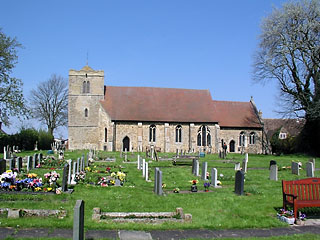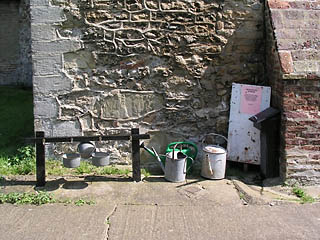The year 2005 started off being a rather fallow year for our journey around Cambridgeshire. The weather was often grim and it was a more attractive prospect to stay in the city, playing boardgames, drinking beer and catching up on the large backlog of notes that had not yet been written up.
In the end, it took until late April for us to visit a new church. Mark had just acquired a new scooter, the previous one having given up the ghost in February [Mark adds: Oh what a world of trials and tribulations are encompassed in so small a word as 'acquired'. I personally imported an Aprilia Scarabeo 500 from Italy.... eventually] so on a bright sunny afternoon we took it out for a spin.
Witchford -along with nearby Wentworth, Witcham and Sutton-in-the-Isle - sits on the same ‘island’ as Ely itself. It is a pretty little village, and a pretty little church. By comparison to illustrious neighbours like Ely and Sutton, St Andrew is rather unprepossessing. The tower is small, barely taller than - and almost swallowed up by - the nave which clasps it with diagonal walls. There are no buttresses, and while the dressed stone corners have held up well, the rubble faces have had to be patched with brick in some places. Without a lot of money, it’s difficult to build grand towers in this corner of the world.
Nave and chancel are rather interesting. Pevsner says that there is evidence of the present church having been dedicated in 1376 - however, the style of the building is mostly Decorated, and therefore more reminiscent of the period before the Black Death in 1348 than the more Perpendicular style that followed. In the chancel we have a classic four-petal design in the tracery of the east window, and the small nave windows are decorated with characteristically curved stonework. There is no clerestory, and the nave walls are very low – the roofline barely higher than the window tops: in almost all respects this is a small, conservative church for a community living in a backwater.
I say ‘almost’, because there is a very interesting departure in the south wall of the nave. The easternmost window is considerably larger than the others and has a very unusual design. It is three-lighted: the centre tall with a cinquefoil head, and either side considerably lower lights with trefoil heads, connected to the middle with unusual swirling lines of tracery. The size and shape of the main lights, with strong vertical mullions, are characteristically Perpendicular – but the free-flowing lines of the tracery harken back to Decorated. All of which shows, I suppose, the danger of attempting too rigidly to categorise architectural styles.
The final addition to the church was the north porch erected in 1887. One of my pet hates, as regular readers may know, is yellow Cambridgeshire brick. But here things are not as bad as usual. The lurid green lichen that seems to thrive on these bricks hasn’t attacked too badly as yet, and the design is lovely – a broad low structure with a tiled roof curving outwards like an oriental pavilion. Inside is a large and cool space, with big stone benches on either side, and a little wrought-iron lantern in the roof. One odd feature is the church doorway itself – the door is obviously set too deep, for someone has at some time been forced to cut into the moulding around the top of the arch to allow it to open.
Not, sadly, that we got to open the door – as with several other churches in the area, St Andrew was locked, and there were no keyholders listed. We had to content ourselves with exploring the graveyard.
At the foot of the tower is a little wooden frame with hooks holding pots and watering cans for the maintenance of the graves and they are indeed very well maintained – a glorious display of flowers greeted us as we looked south from the church. Sulphur yellow butterflies floated around in the warm air, and a lovely view down a slope to a paddock, with a few willow pollards dotted around. then the broad fens beyond, stretching out in pale green under the blue sky. Not a bad place to rest for a while.
St Andrew was locked, with no keyholders listed.

